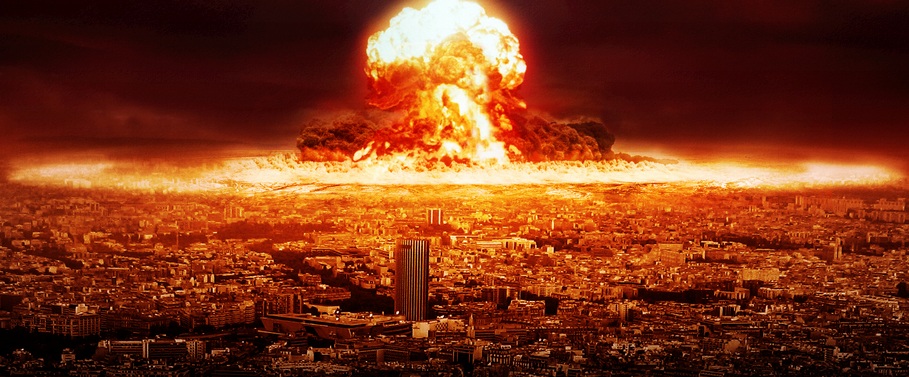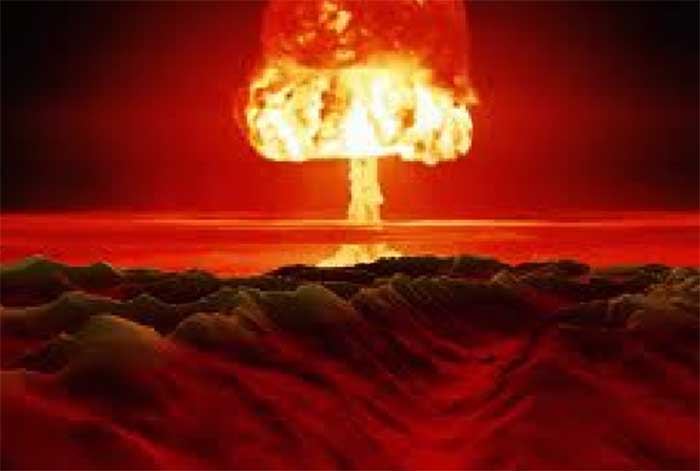
We are all familiar with the climate change denial of Donald Trump and the US Republican Party. Motivated by the greed of giant fossil fuel corporations, climate change denial contradicts the research of the vast majority of scientists and endangers the futire of human civilization and the biosphere.
There exists another very similar greed-motivated denial: It is the denial of the peer-reviewed scientific research on the environmental effects of a nuclear war. In this case, the greed is that of the military-industrial complex against which US President Dwight D. Eisenhower warned in his famous farewell address.
The danger of a catastrophic nuclear war casts a dark shadow over the future of our species. It also casts a very black shadow over the future of the global environment. The environmental consequences of a massive exchange of nuclear weapons have been treated in a number of studies by meteorologists and other experts from both East and West. They predict that a large-scale use of nuclear weapons would result in fire storms with very high winds and high temperatures, which would burn a large proportion of the wild land fuels in the affected nations. The resulting smoke and dust would block out sunlight for a period of many months, at first only in the northern hemisphere but later also in the southern hemisphere.
Temperatures in many places would fall far below freezing, and much of the earth’s plant life would be killed. Animals and humans would then die of starvation. The nuclear winter effect was first discovered as a result of the Mariner 9 spacecraft exploration of Mars in 1971. The spacecraft arrived in the middle of an enormous dust-storm on Mars, and measured a large temperature drop at the surface of the planet, accompanied by a heating of the upper atmosphere. These measurements allowed scientists to check their theoretical models for predicting the effect of dust and other pollutants distributed in planetary atmospheres.
Using experience gained from the studies of Mars, R.P. Turco, O.B. Toon, T. Ackerman, J.B. Pollack and C. Sagan made a computer study of the climatic effects of the smoke and dust that would result from a large-scale nuclear war. This early research project is sometimes called the TTAPS Study, after the initials of the authors.
In April 1983, a special meeting was held in Cambridge, Massachusetts, where the results of the TTAPS Study and other independent studies of the nuclear winter effect were discussed by more than 100 experts. Their conclusions were presented at a forum in Washington, D.C., the following December, under the chairmanship of U.S. Senators Kennedy and Hatfield. The numerous independent studies of the nuclear winter effect all agreed of the following main predictions:
High-yield nuclear weapons exploded near the earth’s surface would put large amounts of dust into the upper atmosphere. Nuclear weapons exploded over cities, forests, oilfields and refineries would produce fire storms of the type experienced in Dresden and Hamburg after incendiary bombings during the Second World War. The combination of high-altitude dust and lower altitude soot would prevent sunlight from reaching the earth’s surface, and the degree of obscuration would be extremely high for a wide range of scenarios.
The temperature inversion produced in this way would lead to superstability, a condition in which the normal mixing of atmospheric layers is suppressed. The hydrological cycle (which normally takes moist air from the oceans to a higher and cooler level, where the moisture condenses as rain) would be strongly suppressed. Severe droughts would thus take place over continental land masses. The normal cleansing action of rain would be absent in the atmosphere, an effect which would prolong the nuclear winter.
In the northern hemisphere, forests would die because of lack of sunlight, extreme cold, and drought. Although the temperature drop in the southern hemisphere would be less severe, it might still be sufficient to kill a large portion of the tropical forests, which normally help to renew the earth’s oxygen.
The oxygen content of the atmosphere would then fall dangerously, while the concentration of carbon dioxide and oxides of nitrogen produced by firestorms would remain high. The oxides of nitrogen would ultimately diffuse to the upper atmosphere, where they would destroy the ozone layer.
Thus, even when the sunlight returned after an absence of many months, it would be sunlight containing a large proportion of the ultraviolet frequencies which are normally absorbed by the ozone in the stratosphere, and therefore a type of light dangerous to life. Finally, after being so severely disturbed, there is no guarantee that the global climate would return to its normal equilibrium.
Even a nuclear war below the threshold of nuclear winter might have climatic effects very damaging to human life. Professor Paul Ehrlich, of Stanford University, has expressed this in the following words:
“…A smaller war, which set off fewer fires and put less dust into the atmosphere, could easily depress temperatures enough to essentially cancel grain production in the northern hemisphere. That in itself would be the greatest catastrophe ever delivered upon Homo Sapiens, just that one thing, not worrying about prompt effects. Thus even below the threshold, one cannot think of survival of a nuclear war as just being able to stand up after the bomb has gone off.”
A few days ago I received a letter from the distinguished English author Anne Baring, whose review of my book “Nuclear Weapons: An Absolute Evil” can be found on the following link:
http://eacpe.org/review-of-book-nuclear-weapons-an-absolute-evil/
Anne Baring informed me of an article published in The Times (February 19, 2018), entitled “Russian spies’ role in the great green hoax”. Here is her letter:
Dear John,
There is an article in The Times today by Matt Ridley (a scientist) that says that the idea of a nuclear winter following a nuclear war or exchange of bombs was propaganda put out by the Soviets during the Cold War in the 80’s to frighten the West. This contradicts the evidence you bring in your book. I wish you could write a letter to The Times mentioning the different research you mention in your book that describes the atmospheric effects of such an exchange.
Best wishes, Anne
I immediately contacted Dr. Steven Starr, whom I knew personally and whom I knew to be an expert on the nuclear winter effect. He quickly wrote the following refutation of the nuclear winter denial that had appeared in The Times:
Regarding https://www.thetimes.co.uk/article/russian-spies-role-in-the-great-green-hoax-rf8h26cd2
To the Editors of the Times,
Matt Ridley and Rupert Darwall are either unaware of ¨C or choose to deliberately ignore ¨C the relatively recent series of peer-reviewed studies done on nuclear winter that have fully substantiated the original studies of the 1980s. Ridley apparently quotes Warner in stating, “By 1986 the theory [of nuclear winter] was effectively dead, and so it has remained.” Sorry, this is factually incorrect.
Beginning in 2007, some of the world’s leading climatologists and physicists at Rutgers, University of Colorado-Boulder, and UCLA used state-of-the-art computer modeling to evaluate a range of possible nuclear conflicts. They found that even a so-called “regional” nuclear war between India and Pakistan, in which a total of 100 Hiroshima-size atomic bombs were detonated in the megacities of these nations, would cause at least 5 million tons of black carbon soot to quickly rise above cloud level into the stratosphere, where it would not be rained out. The smoke would circle the Earth in less than two weeks and would form a global stratospheric smoke layer that would remain for more than a decade.
The smoke would absorb warming sunlight, which would heat the smoke to temperatures near the boiling point of water, producing ozone losses of 20 to 50 percent over populated areas. This would almost double the amount of UV-B reaching the most populated regions of the mid-latitudes, and it would create UV-B indices unprecedented in human history. As the smoke layer blocked warming sunlight from reaching the Earth’s surface, it would produce the coldest average surface temperatures in the last 1,000 years.
The scientists calculated that global food production would decrease by 20 to 40 percent during a five-year period following such a war. Medical experts have predicted that the shortening of growing seasons and corresponding decreases in agricultural production could cause up to two billion people to perish from famine.
The climatologists also investigated the effects of a nuclear war fought with the vastly more powerful modern thermonuclear weapons possessed by the United States, Russia, China, France, and England. Their research found that nuclear firestorms created in such a war would produce up to 180 million tons of black carbon soot and smoke, which would form a dense, global stratospheric smoke layer. The smoke would remain in the stratosphere for 10 to 20 years, and it would block as much as 70 percent of sunlight from reaching the surface of the Northern Hemisphere and 35 percent from the Southern Hemisphere.
Under such conditions, it would only require a matter of days or weeks for daily minimum temperatures to fall below freezing in the largest agricultural areas of the Northern Hemisphere, where freezing temperatures would occur every day for a period of between one to more than two years. Average surface temperatures would become colder than those experienced 18,000 years ago at the height of the last Ice Age, and the prolonged cold would cause average rainfall to decrease by up to 90%. Growing seasons would be completely eliminated for more than a decade; it would be too cold and dark to grow food crops, which would doom the majority of the human population to death by starvation.
The 21st-century peer-reviewed studies that Ridley and Darwall fail to mention are considered to be the most authoritative type of scientific research, which is subjected to criticism by the international scientific community before final publication in scholarly journals. No serious errors were found in these studies and their findings remain unchallenged.
Ridley’s and Darwall’s attempt to characterize valid nuclear winter science as “fake news” ¨C created, of course, by the Russians ¨C is in itself both fake news and a continuation of the smear campaign that has been waged against nuclear winter (and the scientists who discovered it) since the mid-1980s. By publishing “Russian spies’ role in the great green hoax”, the Times did a disservice to its readers.
Sincerely,
Steven Starr
Steven Starr MPH, MT(ASCP)BB
Clinical Laboratory Science Program Director
Assistant Clinical Professor
University of Missouri Hospital and Clinics
John Avery received a B.Sc. in theoretical physics from MIT and an M.Sc. from the University of Chicago. He later studied theoretical chemistry at the University of London, and was awarded a Ph.D. there in 1965. He is now Lektor Emeritus, Associate Professor, at the Department of Chemistry, University of Copenhagen. Fellowships, memberships in societies: Since 1990 he has been the Contact Person in Denmark for Pugwash Conferences on Science and World Affairs. In 1995, this group received the Nobel Peace Prize for their efforts. He was the Member of the Danish Peace Commission of 1998. Technical Advisor, World Health Organization, Regional Office for Europe (1988- 1997). Chairman of the Danish Peace Academy, April 2004. http://www.fredsakademiet.dk/ordbog/aord/a220.htm. He can be reached at [email protected]. To know more about his works visit this link.
http://eacpe.org/about-john-scales-avery/
















































